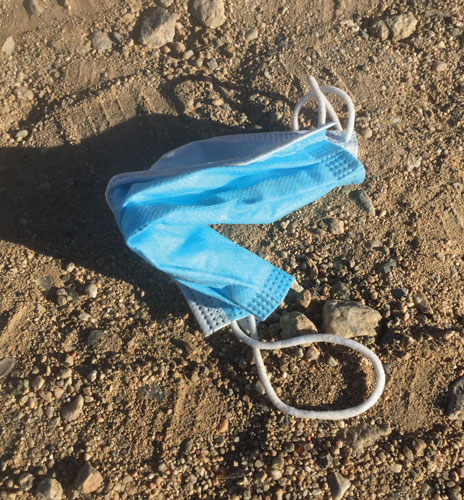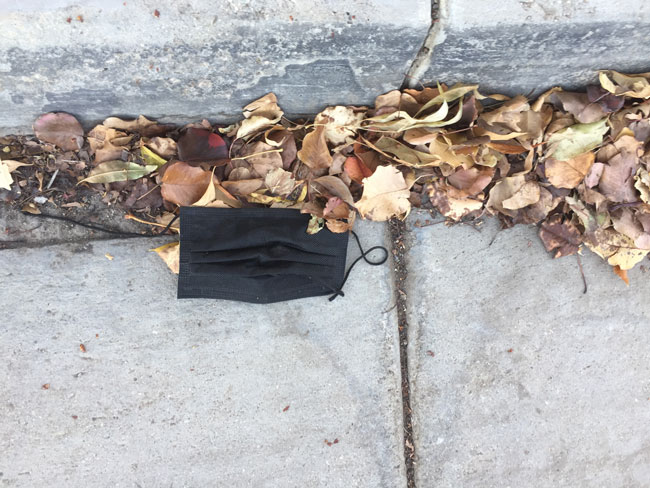With the dramatic increase in use of personal protective equipment (PPE), new challenges in handling, storage, and disposal have arisen.
By Ken Beckstead
Used masks and gloves are being improperly discarded at an alarming rate, and with the possibility of pathogens being present, retrieval, storage and disposal must be done by trained and properly equipped personnel. As we face unprecedented challenges with our current situation, we need to address other possible routes of transmission and adjust accordingly. This will include new Best Management Practices (BMP’s), such as separation, education, and maintenance to ensure that the health of your workers, community, and environment are protected to the maximum extent practicable.
If there is an increase of pathogens in our population, there will be an increase in our waste stream. We have defined protocols for handling different waste items. We need to treat the PPE like we have been treating cigarette butts for 14 years, keep them separate and secure until safe disposal. This has many benefits for the community, such as preventing diseases spreading among the disadvantaged population.

Training Your Staff
Training methods must be tailored to each individual service route to maximize participation and reduce known and possible risks. Training your staff should be an interactive experience that involves identifying hazards that can go beyond their capabilities and how to address them. Hands-on training with explanations of handling and safety procedures with a handout or reminder e-mails for reference will help keep your staff up-to-date at all times. Reminder meetings in the field (tailgate meetings) on a regular basis are also a good way to do your inspections to make sure your safety protocols are being followed. Do not take for granted that everyone knows every term or meaning, having just one misunderstood word can lead to worker confusion. One of the best methods is to have a training video playing at all times, this can be updated with new content to stay relevant.
Signage in every conspicuous location will help remind staff to dispose of their used PPE properly. Ongoing training and program updates will keep the program in the front of everyone’s mind and encourage new ideas. Training on Mondays will help in the retention and application of your program details.
Collection and Handling
The possibility of litigation from someone getting sick digging through your trash due to improperly disposed PPE waste is increasing. Having a used PPE collection and handling plan is a good way to reduce liabilities and help protect the health of your workforce and surrounding communities. The PPE collection and handling plan should follow the PPE from the minute the PPE leaves a person’s hand until final disposal. This would include proper placement of receptacles marked for used PPE only and complimentary signage that is easy to understand. Using pictures and figures will help with language barriers and can help get your point across faster.
A litter study performed for Caltrans demonstrated that people will not walk more than 30 feet to properly dispose of trash. Having PPE-only receptacles in convenient locations will increase program participation. If possible, a different color trash bag should be placed for used PPE-only and the full bags should be kept in a secure area until safe disposal. Most of us have been in the waste industry for some time and have best management practices (BMP’s) that have kept our workers safe. The new BMP’s should include:
- Constant training and updates to have your staff informed with the latest information.
- PPE training for your staff for proper selection, sizing, life span, disposal and, most importantly, purpose of each device. Knowing how to properly wear PPE is one thing; why you wear it is the incentive to use it.
- Documentation of all your efforts including pictures, sign-in sheets for meetings along with the topics discussed, and any issues raised by staff.
- Reviews of your waste stream to see if your program is keeping PPE separate.
- PPE exchange days to ensure PPE is not used past its lifespan.
Once the used materials are collected in bags, they must be sealed until disposal. Having possible pathogens sealed up for a period of time then reopened is an unnecessary risk to your staff and others. There are hazardous waste companies that you can partner with that can help you with every aspect of implementing a successful PPE handling and disposal program. They can come to your facility, assess your current needs, and implement the program in its entirety to keep your staff safe and educated. Having an outside company help implement a PPE program can help reduce liabilities and help your staff morale knowing their health is being protected to the maximum extent practicable.

Photos courtesy of Ken Beckstead.
Educating the Public
PPE masks are mostly made from polypropylene which has a very high BTU potential. When taken to a waste-to-energy facility, the materials produce about 800 watts per pound. This process produces much needed energy while keeping the pathogens from our landfills so future generations do not have to deal with it.
This same material that protects us from pathogens has the great possibility of being ocean plastic pollution. The plastic fibers in mask materials are very fine and break into smaller particles once exposed to UV light. With a recent beach cleanup picking up 61,000 masks, this is a growing problem that is not going away soon.
The public must be educated to properly handle and dispose of the materials such as resealable bags for vehicles so they have proper storage for their used masks until safe disposal is possible. Educating the public has become a challenge due to the lack of in-person events. Since this is the case, use e-mail news updates along with a robust social media campaign to build awareness. People still shop and get gas. Having PPE information stations with disposal receptacles for used PPE at entrances to markets, gas stations and convenience stores can inform the public while providing a safe disposal point. As restrictions loosen, more PPE stations can be placed at banks, gyms, bars and other establishments that have significant foot traffic. In addition, in your local regions, if your PPE goes to a waste-to-energy facility, think about providing information that reflects how much energy you have recovered from that particular waste if possible.
Working Together
We all look forward to the day when we do not have to mask up; until then, we all have to work together to make each other as safe as possible. With new challenges comes new ways to help our planet and each other. Using the best available technology to protect the waters of America and each other is our duty; doing it is our pleasure. | WA
Ken Beckstead is the inventor of the Butts Only Box® cigarette and cigar receptacle. He has been in storm water pollution prevention for 20 years and teaches classes on the effects of cigarette waste on the Waters of America. Cigarette Pollution Solutions offers a system that allows your company to recycle your PPE into energy. Simply ship your bagged waste in 25 pound or less boxes and they charge only .0066 per mask to transform your masks into energy. This comes out to a dollar per pound with the average mask weighing 3 grams. Ken can be reached at (760) 845-5285, e-mail [email protected] or visit www.buttsonlybox.com.
